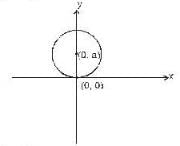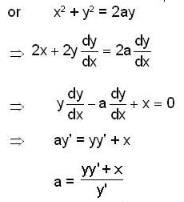Mathematics Exam > Mathematics Questions > The differential equation representing the fa...
Start Learning for Free
The differential equation representing the family of circles touching x-axis at the origin is
- a)linear and of first order
- b)linear and of second order
- c)non linear and of first order
- d)non linear and of second order
Correct answer is option 'C'. Can you explain this answer?
| FREE This question is part of | Download PDF Attempt this Test |
Verified Answer
The differential equation representing the family of circles touching ...
The equation of the family of the circles touching x-axis at the origin is
x2 + (y-a)2 = a2



Most Upvoted Answer
The differential equation representing the family of circles touching ...
The equation of the family of the circles touching x-axis at the origin is
x2 + (y-a)2 = a2



Free Test
FREE
| Start Free Test |
Community Answer
The differential equation representing the family of circles touching ...
Explanation:
Differential Equation:
A differential equation is an equation that relates a function with its derivatives. It represents the relationship between the function and its rate of change.
Family of Circles:
A family of circles is a collection of circles that share a common characteristic. In this case, the circles in the family touch the x-axis at the origin.
Linear and Nonlinear:
A differential equation is linear if it is linear in the dependent variable and its derivatives. A differential equation is nonlinear if it is not linear in the dependent variable and its derivatives.
First and Second Order:
The order of a differential equation is determined by the highest order derivative that appears in the equation. A first-order differential equation has only first derivatives, while a second-order differential equation has second derivatives.
Explanation:
The equation of a circle with radius r and center (a, b) can be written as:
(x - a)^2 + (y - b)^2 = r^2
Since the circles in the family touch the x-axis at the origin, the center of each circle will be (a, -r), where a is the x-coordinate of the center and r is the radius.
Substituting the values in the equation of a circle, we get:
(x - a)^2 + (y + r)^2 = r^2
Expanding and rearranging the equation, we get:
x^2 - 2ax + a^2 + y^2 + 2ry + r^2 - r^2 = 0
Simplifying further, we have:
x^2 - 2ax + a^2 + y^2 + 2ry = 0
This equation represents the family of circles touching the x-axis at the origin. It is a nonlinear equation because it contains the product of x and y terms. Additionally, it is a first-order equation because it contains only first derivatives.
Therefore, the correct answer is option 'c' - non-linear and of first order.
Differential Equation:
A differential equation is an equation that relates a function with its derivatives. It represents the relationship between the function and its rate of change.
Family of Circles:
A family of circles is a collection of circles that share a common characteristic. In this case, the circles in the family touch the x-axis at the origin.
Linear and Nonlinear:
A differential equation is linear if it is linear in the dependent variable and its derivatives. A differential equation is nonlinear if it is not linear in the dependent variable and its derivatives.
First and Second Order:
The order of a differential equation is determined by the highest order derivative that appears in the equation. A first-order differential equation has only first derivatives, while a second-order differential equation has second derivatives.
Explanation:
The equation of a circle with radius r and center (a, b) can be written as:
(x - a)^2 + (y - b)^2 = r^2
Since the circles in the family touch the x-axis at the origin, the center of each circle will be (a, -r), where a is the x-coordinate of the center and r is the radius.
Substituting the values in the equation of a circle, we get:
(x - a)^2 + (y + r)^2 = r^2
Expanding and rearranging the equation, we get:
x^2 - 2ax + a^2 + y^2 + 2ry + r^2 - r^2 = 0
Simplifying further, we have:
x^2 - 2ax + a^2 + y^2 + 2ry = 0
This equation represents the family of circles touching the x-axis at the origin. It is a nonlinear equation because it contains the product of x and y terms. Additionally, it is a first-order equation because it contains only first derivatives.
Therefore, the correct answer is option 'c' - non-linear and of first order.

|
Explore Courses for Mathematics exam
|

|
The differential equation representing the family of circles touching x-axis at the origin isa)linear and of first orderb)linear and of second orderc)non linear and of first orderd)non linear and of second orderCorrect answer is option 'C'. Can you explain this answer?
Question Description
The differential equation representing the family of circles touching x-axis at the origin isa)linear and of first orderb)linear and of second orderc)non linear and of first orderd)non linear and of second orderCorrect answer is option 'C'. Can you explain this answer? for Mathematics 2024 is part of Mathematics preparation. The Question and answers have been prepared according to the Mathematics exam syllabus. Information about The differential equation representing the family of circles touching x-axis at the origin isa)linear and of first orderb)linear and of second orderc)non linear and of first orderd)non linear and of second orderCorrect answer is option 'C'. Can you explain this answer? covers all topics & solutions for Mathematics 2024 Exam. Find important definitions, questions, meanings, examples, exercises and tests below for The differential equation representing the family of circles touching x-axis at the origin isa)linear and of first orderb)linear and of second orderc)non linear and of first orderd)non linear and of second orderCorrect answer is option 'C'. Can you explain this answer?.
The differential equation representing the family of circles touching x-axis at the origin isa)linear and of first orderb)linear and of second orderc)non linear and of first orderd)non linear and of second orderCorrect answer is option 'C'. Can you explain this answer? for Mathematics 2024 is part of Mathematics preparation. The Question and answers have been prepared according to the Mathematics exam syllabus. Information about The differential equation representing the family of circles touching x-axis at the origin isa)linear and of first orderb)linear and of second orderc)non linear and of first orderd)non linear and of second orderCorrect answer is option 'C'. Can you explain this answer? covers all topics & solutions for Mathematics 2024 Exam. Find important definitions, questions, meanings, examples, exercises and tests below for The differential equation representing the family of circles touching x-axis at the origin isa)linear and of first orderb)linear and of second orderc)non linear and of first orderd)non linear and of second orderCorrect answer is option 'C'. Can you explain this answer?.
Solutions for The differential equation representing the family of circles touching x-axis at the origin isa)linear and of first orderb)linear and of second orderc)non linear and of first orderd)non linear and of second orderCorrect answer is option 'C'. Can you explain this answer? in English & in Hindi are available as part of our courses for Mathematics.
Download more important topics, notes, lectures and mock test series for Mathematics Exam by signing up for free.
Here you can find the meaning of The differential equation representing the family of circles touching x-axis at the origin isa)linear and of first orderb)linear and of second orderc)non linear and of first orderd)non linear and of second orderCorrect answer is option 'C'. Can you explain this answer? defined & explained in the simplest way possible. Besides giving the explanation of
The differential equation representing the family of circles touching x-axis at the origin isa)linear and of first orderb)linear and of second orderc)non linear and of first orderd)non linear and of second orderCorrect answer is option 'C'. Can you explain this answer?, a detailed solution for The differential equation representing the family of circles touching x-axis at the origin isa)linear and of first orderb)linear and of second orderc)non linear and of first orderd)non linear and of second orderCorrect answer is option 'C'. Can you explain this answer? has been provided alongside types of The differential equation representing the family of circles touching x-axis at the origin isa)linear and of first orderb)linear and of second orderc)non linear and of first orderd)non linear and of second orderCorrect answer is option 'C'. Can you explain this answer? theory, EduRev gives you an
ample number of questions to practice The differential equation representing the family of circles touching x-axis at the origin isa)linear and of first orderb)linear and of second orderc)non linear and of first orderd)non linear and of second orderCorrect answer is option 'C'. Can you explain this answer? tests, examples and also practice Mathematics tests.

|
Explore Courses for Mathematics exam
|

|
Suggested Free Tests
Signup for Free!
Signup to see your scores go up within 7 days! Learn & Practice with 1000+ FREE Notes, Videos & Tests.
















